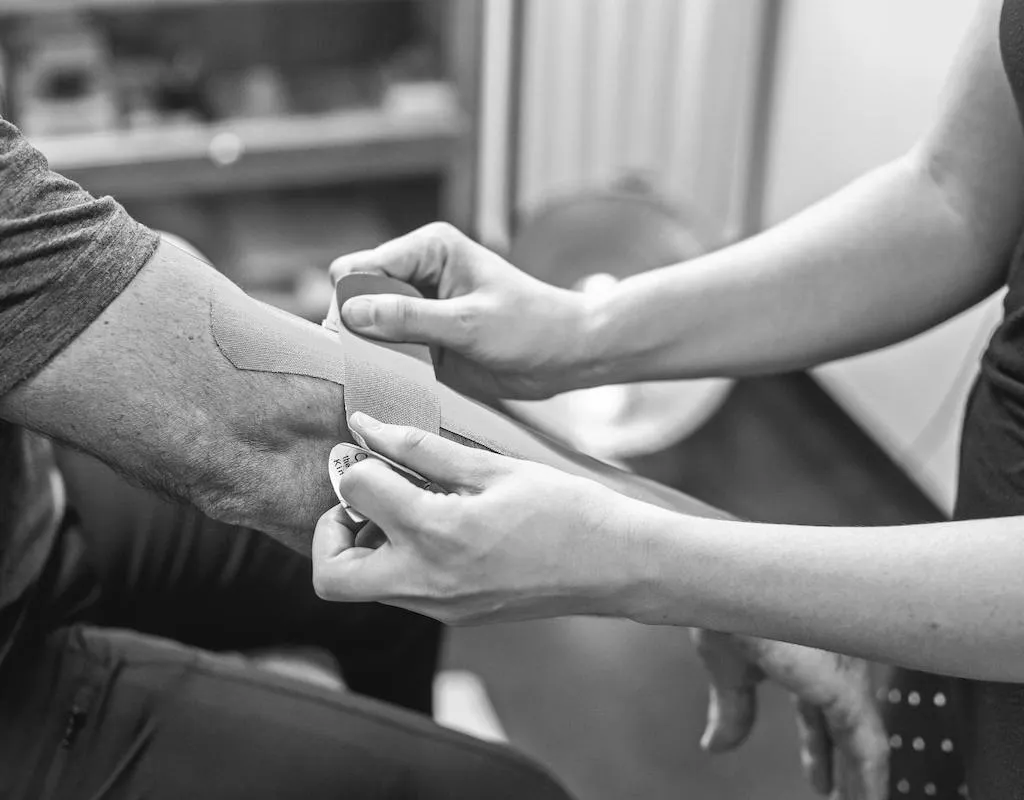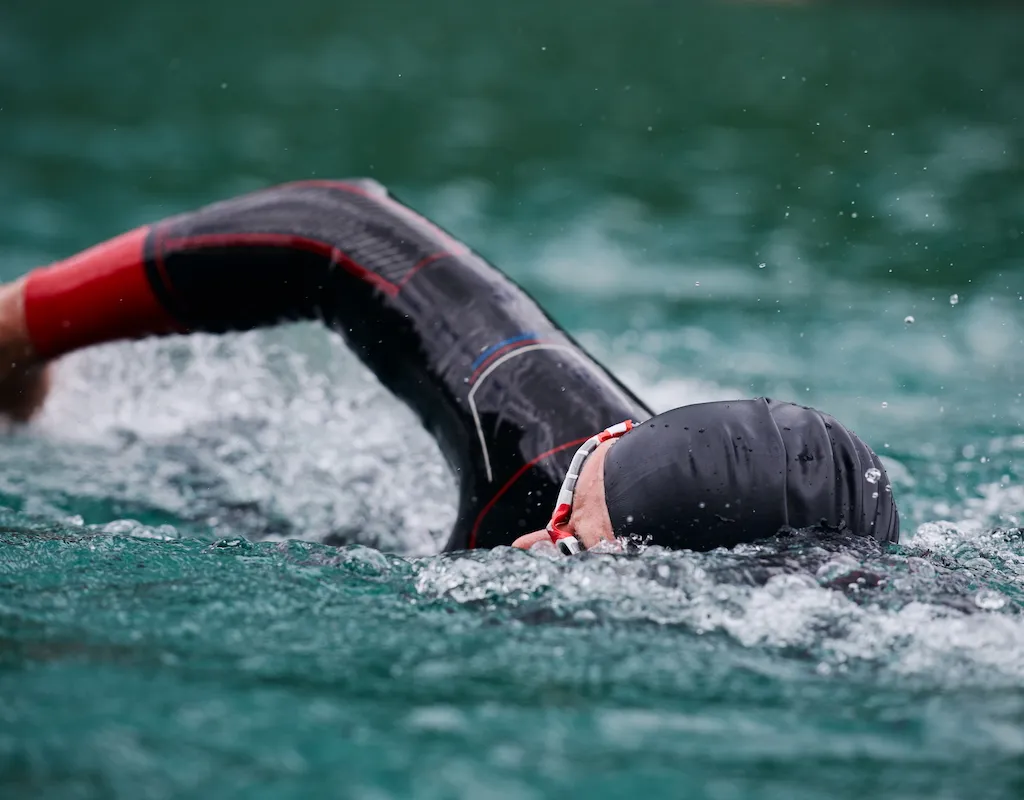Swim regularly but got a wound and wondering if it’s safe to continue swimming? Here, doctor and Swim England clinical advisor Dr Hussain Al-Zubaidi shares the answers and explains how to waterproof a wound for swimming.
Swimming is a great way to stay active and enjoy the water but it’s essential to take proper precautions when you have a wound to prevent infections, delayed healing and irritation.
In this comprehensive guide, we’re going to explain how to waterproof different types of wounds for swimming and outline the safety measures you should undertake to look after yourself and others.
How to waterproof a small wound for swimming
Small wounds, such as minor cuts and scrapes, can be effectively waterproofed to allow swimming without increasing the risk of infection. Here’s how you can do it:
1. Clean the wound thoroughly
Before waterproofing the wound, clean it gently with mild soap and water or saline solution.
Ensure there’s no remaining dirt or foreign objects still within the wound. Pat it dry with a clean non-adherent cloth.
2. Apply an antiseptic ointment (e.g. Neosporin)
This can help prevent infections while also creating a protective barrier over the wound.
3. Use waterproof bandages
These are specifically designed for swimming or showering and are available at most pharmacies or supermarkets.
These bandages are made of waterproof materials that aim to keep the wound dry even when submerged in water.
My experience with these has been varied, to be honest. Half the skill is in applying it well and the difficulty will depend on the location of the wound.
4. Seal the edges
To ensure complete waterproofing, seal the edges of the bandage with a waterproof adhesive tape.
This additional step prevents water from seeping into the wound, especially in trickier locations. Think of it as a belts and braces approach!
5. Change the bandage after swimming
Even waterproof bandages may lose their effectiveness after extended periods in the water.
Therefore, change the bandage immediately after swimming to keep the wound clean and dry.
How to waterproof a larger wound for swimming

Waterproofing larger wounds, such as abrasions or lacerations, requires more care and attention to prevent infections.
You should also seek a review with a healthcare professional prior to swimming with such a wound.
Some may not be suitable for any prolonged exposure to water. Here’s a step-by-step process to follow if you’re given the green light by your medical professional:
Like with smaller wounds, it’s important to clean the wound carefully using a saline solution or mild antiseptic solution.
Avoid using hydrogen peroxide or alcohol-based solutions, as these can damage healthy tissues.
Apply antibiotic ointment and cover the wound with sterile dressings that are large enough to provide adequate coverage.
Secure the dressings with waterproof adhesive tapes. Make sure the entire area is sealed tightly to prevent water entry.
Consider waterproof cast covers
If the wound is on a limb that’s in a cast, special waterproof cast covers are available. These covers seal the cast, allowing you to swim without the risk of water damaging the cast or entering the wound.
I don’t have personal experience using these but feedback from patients is that they’re effective in keeping the limp protected. Some good examples can be found here.
Monitor for signs of infection
Even with waterproofing and the application of antiseptic creams, it’s crucial to monitor the wound for any signs of infection, such as increased redness, pain, swelling, warmth, or discharge.
If you notice any of these symptoms, consult a healthcare professional promptly as skin infections can worsen to either cause more serious damage to the skin, spread further or lead to more systemic infection.
How to keep stitches dry while swimming

If you’ve recently undergone surgery and have stitches, keeping them dry while swimming is essential to prevent complications. Here’s how you can protect stitches while swimming…
To start, it’s essential that you always follow your healthcare team’s specific instructions regarding wound care and swimming.
They might provide specialised waterproof dressings or recommend certain products to keep the stitches dry. Some simply will not be safe to swim with within certain time frames.
If your healthcare professional has said it’s okay to swim, here’s some advice to follow.
Use waterproof dressings designed for stitches
These are available in most pharmacies. These dressings are sterile and adhere securely to the skin, forming a waterproof barrier over the stitches.
Avoid prolonged immersion
While waterproof dressings offer protection, it’s best to avoid prolonged immersion in water. Quick swims with minimal soaking of the wound are generally safer.
Remember that the area around stitches is at risk of developing infection
Just like with any wound, monitor the area around the stitches for signs as outlined above. If you notice any unusual symptoms, contact your healthcare provider promptly.
Is chlorine bad for open wounds?
Chlorine is a disinfectant commonly used in swimming pools to kill harmful bacteria.
While it's generally safe in properly chlorinated pools, it can cause irritation in open wounds.
Chlorine may slow down the natural healing process by damaging the delicate tissues around the wound. Moreover, some individuals might be more sensitive to chlorine than others.
To minimise the effects of chlorine on open wounds take similar approaches as outlined above, including bandaging, limiting time in the chlorinated water and rinsing the area with tap water after exposure, followed by patting it dry.
Should I go swimming in the ocean with cuts and scrapes?

Saltwater can help and hurt. The salt in seawater can help cleanse wounds to some extent. Salty water is what the cleaning solution saline essentially is.
However, ocean water also contains bacteria and other microorganisms in varying concentrations that can lead to infections.
At the World Triathlon Championship Series race this year in Sunderland, dozens of participants complained of illness post-event.
Reports of sewage being dumped into open waters have led to growing concerns of safety in our natural blue spaces.
It's generally not advisable to go swimming in the ocean with cuts and scrapes. Here are a few reasons why:
1. Risk of infection
The ocean water is not sterile; it contains bacteria, viruses, and other microorganisms. If you have open wounds, these pathogens can enter your body, increasing the risk of infection.
Even minor cuts and scrapes can become infected in the presence of these microorganisms.
2. Saltwater irritation
Ocean water, especially if it's salty, can sting open wounds and cause discomfort. This can make your swimming experience unpleasant and may even slow down the healing process.
3. Difficulty in wound healing
Submerging cuts and scrapes in water for extended periods can soften the skin and delay the natural healing process.
It may also wash away the protective scab that forms over the wound, making it vulnerable to further injury and infection.
4. Risks of marine life
Depending on the location, there might be marine life, like jellyfish or sea urchins, which could pose additional risks to your open wounds.
Depending on where you’re swimming in the world, it’s important to note that sharks have a very keen ability to detect blood.
Although I’m sure sharks have been grossly misrepresented in Jaws, you may want to avoid testing your luck.
If you really want to swim, it's better to wait until your cuts and scrapes have fully healed and sealed.
In the meantime, you can enjoy other physical activities that don't involve submerging your wounds.
And always make sure to clean and properly dress your wounds to prevent infections, even when not swimming.
Are there any wounds that I shouldn’t swim with?

While small cuts and scrapes can often be adequately protected for swimming, certain types of wounds should not be submerged in water. These include:
Deep wounds
Wounds that are deep enough to require stitches or staples should not be submerged in water until they have been closed and your healthcare team have given the green light.
Immersing these wounds in water can increase the risk of infection and disrupt the healing process.
Puncture wounds
Puncture wounds, such as those caused by nails or sharp objects, are prone to trapping bacteria deep inside the tissue. Submerging these wounds in water can introduce contaminants and lead to severe infections.
Infected wounds
If a wound is already infected, swimming can worsen it. Signs include increased redness, swelling, warmth, and discharge.
Infected wounds require medical attention and should not be exposed to water.
Surgical wounds
If you’ve recently undergone surgery, follow your healthcare provider’s instructions regarding wound care and swimming. Surgical wounds often require specific care to prevent complications.
Recap
In conclusion, while swimming with small, waterproofed wounds might be feasible, it’s crucial to exercise caution and prioritise wound care.
For larger, punctured, or infected wounds, it's generally safer to avoid swimming until it has fully healed.
Always consult a healthcare provider if you have concerns about swimming with a particular wound to ensure proper care and minimise the risk of complications.
I know what it’s like to be frustrated and eager to jump back in the water, but it’s important to consider professional advice and focus on maximising the healing so you can get back into the water quicker.
Fitness can be maintained through cross training with land based activities and the water will be there for you once you’re ready.
Looking for more advice on training with injuries or illness? See our articles on swimming with a cold and swimmer's shoulder for specific advice, or head to our 'injuries' section for more.
Top image credit: Getty Images
